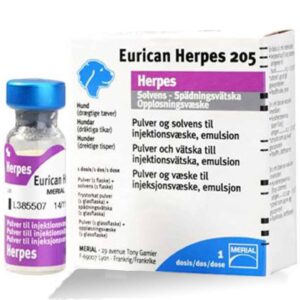Canine Herpes Virus – In Adult Dogs & Puppies
Ron Hines DVM PhD

Some Facts About Canine Herpes Virus
There are a lot of different herpes viruses. Practically every animal species has one or more of their own – even fish and snakes. You probably know about several that affect us humans: herpes simplex, chickenpox and mononucleosis. Cats have their own. (read here) None of those are a threat to your dog. But canine herpes virus (CHV1, aka CaHV-1) affects dogs and their wild canine relatives. In healthy adult dogs, CHV1, at the most, usually causes a mild upper respiratory tract inflammation with a slight cough – quite similar, and sometimes even part of the the kennel cough complex.
Unfortunately, just like the cold sore herpes that many of us harbor, herpes virus of dogs (CHV1) has the ability to hide dormantly (sleeping/latent) in your dog’s body indefinitely. There it can take advantage of periods of stress to reemerge (= recrudescence). Another common cause of herpes reactivation in adult dogs is the administration of drugs that depress your dog’s immune system. (read here & here) Most often but not always, that occurs with no signs of illness apparent in your pet, but with the ability to infect other susceptible dogs that it comes in contact with.
Exposure to canine herpesvirus-1 is extremely common worldwide. In one Norwegian study, 85.5% of 193 purebred dogs sampled carried antibodies that confirmed prior exposure to the virus. (read here) A problem with just looking for antibodies against herpes virus as evidence of exposure is that those antibodies tend to drop to levels below the test’s ability to detect them during stress-free periods. So antibody-based tests always underestimate the viruses’ true prevalence. Like all viral diseases, exposure is more likely to occur in large breeding kennels, shelters and doggy daycare centers than in a household with one or two canine members.
The canine herpes virus (CHV1) would not rate nearly as much interest as it does if it were not for one of its unique peculiarities. When a new infection or a flare-up reoccurs during your female dog’s pregnancy, it can lead to fetal death or sudden severe (fulminating) infections in the dog’s puppies (up through their 3rd week of life). The canine herpes virus thrives and multiplies best at temperatures slightly lower than the normal body temperature of adult dogs (normally 101–101.5 F / 38-39 C). Very young puppies have trouble maintaining that temperature. That slightly lower body temperature – plus their lack of antibodies against herpes virus from prior exposure – make puppies very susceptible to fatal herpes disease should the virus obtain entry to their bodies. A puppies’ incompletely developed immune system make the situation for them even worse. (read here)
If My Adult Dog Carries The Herpes Virus, How Did It Catch it?
When a dog is first infected with the herpes virus, or when the virus reactivates in a carrier dog, the virus is shed in all of its moist secretions: sneezes, coughs, vaginal secretions and semen. No one has studied how long the canine herpes virus can survive in the environment. However, all herpes viruses, being double-stranded DNA viruses, can persist outside of their hosts for quite some time. The one that infects horses and other hoofed animals, EHV-1, remains infective on the ground or on objects for up to 21 days and up to 14 days when it contaminates water. In bright sunshine and summertime temperatures the viruses of human herpes are known to inactivate more rapidly.
When genital transfer occurs, it is usually from the mother dog to her own puppies as they pass through her birthing canal. Many of these female dogs are young. It is often only their first litter that is effected and and never again occurs. Perhaps she became pregnant during her first encounter with the virus and on subsequent pregnancies the virus was already in its latent, inactive state. That has not been confirmed nor is it likely to be a hard and fast rule. All pregnancies require some degree of immune system modifications that can reactivate “sleeping” virus. (read here)
What Are Some Other Signs That My Dog Might Carry The Herpes Virus?
The majority of dogs that carry canine herpes virus show no obvious signs that they are sick – even when the virus is proliferating. Routine laboratory test are not helpful in detecting infection either. But if symptoms do occur, the most common are transient, mild, upper respiratory inflammation resulting in sneezing, and/or a cough. Genital signs are considerably less common. But when they occur, they include blisters and ulcers (vesicular lesions) similar to cold sores and inflammation in the dog’s vaginal area, or on the prepuce and base of a male dog’s penis. A few dogs run fevers. If symptoms occur, they are often after periods of stress, such as new dogs in the family, boarding, or environmental changes in your home. Serological tests exist to confirm prior exposure (the presence of anti-herpes antibodies) and PCR tests exist to identify the virus when it is proliferative rather than in its dormant state.
Herpes crosses the mind of veterinarians most frequently when a dog owner complains of a lack of breeding success and/or stillborn or star-crossed puppies that die within their first 3 weeks of life. Some vets have reported that on rare occasion, canine herpes inflammation has been limited to the puppy’s eyes (dendritic corneal ulcers and/or conjunctivitis).
What Are Some Other Signs Of Herpes In Puppies?
As I mentioned, if your mother dog experiences a rise in herpes virus numbers (relapse or primary herpes infection) near the end of her pregnancy, without a sufficient rise in her anti-herpes antibody level, it is common to lose all or some of the puppies during their first three weeks of life. Puppies born from mothers that have a decent antibody level against herpes are protected throughout that critical period. If the mother dog has adequate immunity herself, she passes it along in her first milk (colostrum) in the form of anti-herpes antibody and immune cells that protect her offspring. If for some reason the puppies did not receive colostrum from a herpes-positive mother, their risks increase.
The most commonly described scenario are puppies born apparently normal; but which suddenly experience an abrupt (“fulminating”) death 1-2 days later. At the most, death might be preceded by a short period of listlessness. The first sign is often a lack of interest in nursing. Some whine continuously and appear uncomfortable. Others have tender or bloated tummies. Their breathing is often fast and shallow, their temperature sub-normal. They might vomit back milk when you try to assist by bottle feeding them. Nose and eye discharges are not unusual. Some have reported pinpoint hemorrhages on the puppy’s gums; others, an increased tendency for bleeding or seizures. None of these signs are specific for canine herpes. Some might just call it “fading puppy syndrome”.
Young puppies, are not capable of running fevers. Their body mass is just not large enough in proportion to their skin area through which heat is lost. This is a major threat to puppies dealing with herpes. That is because the herpes virus reproduces more rapidly at the puppy’s lower body temperature than it would in older dogs that can mount a fever. Subnormal temperature in a puppy ( less than 95 – 99 F / 35° to 37.2 C [week 1], 97 – 100 F [weeks 2-3] ) is always a grave sign. Because things move downward at such a rapid rate, dog owners often do not recognize that the puppy is in trouble until it is gone. Puppies lost within the first three weeks or stillborn were either infected while still in the womb or during birth. If the puppies were infected early in the pregnancy, dog owners might mistakenly think that their dog just did not conceive or that she or the stud were infertile. When CHV1 occurs in somewhat older puppies, respiratory signs more severe than in adults, can be part of the picture.
The protection the the maternal antibodies of the mother afford to their puppies through their first milk (colostrum) can be only partial. If these partially-protected, but infected puppies do survive, they sometimes remain “poor doers” that continue to suffer from multiple health issues including stunted growth, heart and nerve damage. When a mother dog gives birth, it is quite possible for some of the puppies to become infected as they pass through the birth canal while others avoid infection. So, some may thrive and some may not. It is also possible for the infected puppies to pass the virus to their littermates after birth. So, there can be a second spike in puppy mortality 3-7 days after the first. In all of these scenarios, your mother dog generally remains healthy and acts normally.
What About Treatment Options For Canine Herpes?
For infected young puppies, nothing has yet been found that slows or reverses the course of the disease. Treatment is generally unrewarding. As I mentioned, because the virus causes damage throughout the puppy’s body, even puppies that survive infection are often left with brain, kidney and liver problems. Since most puppy owners rush in with the puppy(s) at death’s door, there is no time to send to the lab to even confirm the problem is herpes. So, your vet may hope it isn’t herpes and proceed with life-supporting measures including warmth, tube feeding, oxygen and intravenous or subcutaneous fluids. Pups tend to perk up a bit with this care – but they fade back down shortly thereafter. Although elevated temperature kills this herpes virus, treating the puppy with elevated temperature has not proved effective in saving infected pups. There are those that disagree – particularly when puppies not yet ill are separated into isolettes (pediatric incubators) where ambient and body temperature can be accurately adjusted (95° F /35° C, 50% relative humidity). There are also reported cases of puppies being saved by giving them blood serum from adult dogs that recently recovered from a herpes virus episode. Blood serum obtained from an adult dog – particularly a kenneled dog – in that situation might contain enough antibodies to neutralize the herpes virus. Others reported that the antiviral drug, vidarabine, saved some puppies and still others have attempted to use acyclovir – since that medication is commonly given to humans with herpes virus flare-ups. Veterinarians have little to offer you once your adult dog has become a confirmed CHV1 carrier. We can dispense medications to help with any respiratory or eye issues. That plus rest and TLC are all the majority of adult dogs need to get over the active stage of herpes infection or a relapse. Remember that the vast majority of dogs that become infected with canine herpes will go through a mild initial upper respiratory tract illness that lasts a week or two and then are never visibly sick again. Most of those dogs still carry “sleeping” (dormant) living herpes virus deep within their nervous system. But they are extremely unlikely to pass those virus on to their puppies unless they are faced with major stress during or just after pregnancy.
What About Anti-Canine Herpes Vaccinations?
Some years ago, Merial, a French company and now a division of Boehringer Ingelheim, introduced an inactivated (subunit) canine herpes vaccine that appeared to boost antibody protection in adult dogs for about 60 days. The thought was that if you gave the vaccine just before breeding your dog, it would be less likely to be shedding herpes virus during and just after its pregnancy. It was also hoped that some of that increased antibody would be passed on to the puppies though the mother’s first milk (colostrum). This vaccine is called Eurican® Herpes 205. Although studies on its effectiveness were minimal, it appeared that it could have positive effects and little or no side effects. So, the EMA approved its use in Europe and the UK. I do not believe that Boehringer ever requested permission to market this vaccine in North America, but I could be wrong. The vaccine would probably not earn the Company enough money in North America to justify the bureaucratic expenses involved. The first injection of Eurican® Herpes 205 was to be given when the female was bred. The second to be given 6-7 weeks later. The process was to be repeated every time the dog was bred, since the immunity it hoped to impart was temporary. Perhaps it was good insurance for first-time breeders and repeat problem breeders. Because the vaccine did not contain complete herpes virus, it was said to not interfere with PCR-based diagnostic tests. Living in America, I had no experience administering it. Since its introduction, it was unobtainable in Europe on multiple occasions. As 2022 comes to a close, most European and UK vaccine suppliers list the vaccine as out of stock with no anticipated delivery date. If it comes back on the market, let me know, and I will modify this page.
If I Experienced One Herpes Star-Crossed Litter, Should I Breed My Dog Again?
Yes, if you are motivated to do so. No, if it has occurred twice.
You are on the Vetspace animal health website
Visiting the products that you see displayed on this website help pay the cost of keeping these articles on the Internet.


